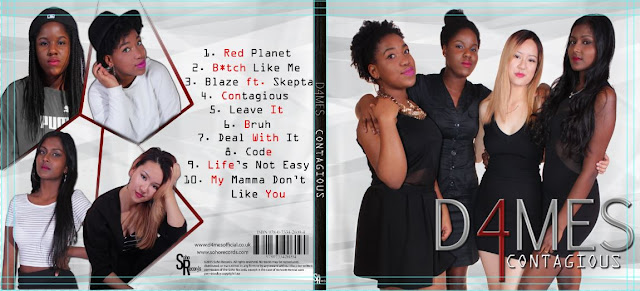We had already drawn up a rough flat plan of how we wanted our digipak to look so this was our point of reference whilst editing. However, there were certain stages where we couldn't follow the flat plan exactly and so had to make executive decisions about key things.
 |
| Template |
We started off with the template which was colour coded:
- Green: the main space of the digipak where all images/texts should be placed
- Blue: the area that allows for a bit of spillover but there is a chance that it may get cut off during.printing
- Red: the bleed area - nothing should be there as it will get cut off during printing
 To begin with, we had the tough decision of going through all our promotional stills and choosing the pictures that we thought best reflected the band and would suit our album. This took quite a while and we still got it wrong and changed it multiple times throughout the editing process. For example, at the early stages the picture we chose to use as our main, focal picture on the front our album cover was:
To begin with, we had the tough decision of going through all our promotional stills and choosing the pictures that we thought best reflected the band and would suit our album. This took quite a while and we still got it wrong and changed it multiple times throughout the editing process. For example, at the early stages the picture we chose to use as our main, focal picture on the front our album cover was:But this is the actual, final picture that we ended up using, after much deliberation as we felt this picture looks more professional and represents the band in a better light.
- After choosing the picture, we then had to edit the picture to make it look more professional using things like the 'skin smoothing' process in Photoshop. This process involved using tools such as the clone stamp and spot healing tools to edit the pictures. This process was long and lengthy and required a lot of patience.
 |
| Angela and I using the spot healing tool to edit Monica's picture. |
- We then had to remove the white background of the pictures using the quick select tool and also the refine edge tool. On the left is a picture of me using these tools to remove the background off of one of our shots.
- Here is a video showing two members of my group using the refine edge tool and then going back over the edges to fix them:

- Once we had made those changes we ended up with this:
We were happy with the way this version looked but we were not sure about the positioning or the font of the 'D4MES' logo. We therefore sought audience and teacher feedback on what we should do. Both parties advised us to get rid of the 'stamp' effect on the logo as they said it looked 'tacky and didn't do the album cover any justice'. So, we got rid of it and ended up with a front and back cover that we all really liked and thought worked well for the band:

- Once we were happy with the front and back of the digipak, we had to focus on the inside cover. We started off by choosing a black background as we thought the contrast with the white on the outside would look good. However, after audience feedback, many said that the black background made the digipak 'look mismatched'. So we had to change this.
- We tried to play around with certain effects to make it look like we were almost embedded into the digipak but in a variety of different colours. However, we did not like this fit in with our band image or identity and again made the digipak look even more mismatched so we started again.
- When we went back to the drawing board, we realised that it was probably better to keep the background across all four panels the same in order to create that sense of everything working together. We did this and we also liked the way it looked. Instead of embedding the image onto a multi-coloured backdrop we decided to embed it into the white and grey one to keep the monochrome theme running throughout. We also decided to add all of the band members name so that it didn't look empty on the inside.
I was very pleased with the final outcome of our digipak. It was very time-consuming and required a lot of replanning and rethinking our ideas but in the end, I feel like it all came together really well and we worked really well as a group to create a professional looking, promotional digipak for our band.









No comments:
Post a Comment